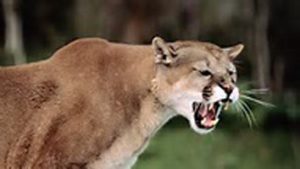Cougars: Are They in Maine?

By V. Paul Reynolds
The question persists. More than 25 years ago, as editor of the official magazine for the Maine Department of Inland Fisheries and Wildlife (MDIF&W), the same question was addressed by me in an article that sought to dig deep and find credible answers.
At the time, despite a number of anecdotal cougar-sighting reports from citizens, state and federal wildlife biologists and research people remained highly skeptical. On one occasion, a Maine Allagash Waterway visitor insisted that he had seen a cougar crossing the waterway. The “witness” had taken what he claimed was solid evidence: a color 35 mm slide. Biologist and wildlife director Ken Elowe agreed to study the image carefully and render a verdict.
As information officer for MDIF&W I was included in the effort to carefully study the photo of what was claimed to be a mountain lion standing on the banks of the Allagash Waterway. My recollection is that the Department borrowed a special forensics microscopic device from the Maine State Police. Biologists used the device to really zoom in on the mysterious critter. The device also had an enhancement option that brought some induced clarity to the somewhat fuzzy photo.
The official verdict? Not a lion, a fisher. My further recollection is that the well-intentioned fellow who saw his “cat” and took the photo was not pleased with the official determination, and left in a huff, and like so many others who have reported to have seen the elusive cats, insisted, “ I know what I saw. It sure as hell was not a fisher, it was a cat!”
Not a lot has changed in 25 years, at least not in terms of empirical evidence or the official positions of Maine and federal wildlife biologists when it comes to the presence of mountain lions or cougars in Maine.Cougars: Are They in Maine?
Two key players from the biologists ranks are Mark McCollough, the endangered species specialist from the U.S. Fish and Wildlife service in Orland and Nathan Webb, wildlife director for MDIF&W. Webb’s Department lists its cougar position in one short sentence on the MDF&W website: “No known cougar populations exist in Maine.”
Webb told me, “ We do get several reports every year, but most are not credible, or are lacking evidence. I was fortunate to participate in field research on cougars in western Canada for quite a few years, so I have a particular interest in this species and the public reports that we receive. I am very confident that if a breeding population did exist, it would not take us long to detect it.”
McCollough, who has been a longtime skeptic about a cougar population in Maine and played a role in the Federal de-listing of the sub-species of cougar in the Northeast, had this to say recently: “ We get a few reports every year. The most “promising” was the animal filmed by ice anglers in northern Maine late last winter (about a year ago). The video and tracks were intriguing. Otherwise, in recent months I’ve received reports from Karen Holmes, another writer for the NWSJ. Like many, they are 3rd hand accounts of someone seeing an alleged cougar. Not much to follow up on for concrete evidence.”
The official position of the U.S Fish and Wildlife Service (USFWS) is straight-forward and unequivocal. It contends that any dispersing cougars actually in Maine, or those seen and confirmed in New Brunswick or Ontario, are not ancestors of Maine’s once-active cougar subspecies. The last confirmed mountain lion in Maine dates back to 1932. USFWS says, “Cougars in the East (today) are Florida panthers, released captives, or those dispersed from the West.
Is there a voice from the other side, anyone with credentials who takes issue with the official position
of the wildlife biological community?
Enter Bill Betty from Rhode Island. Betty is a dedicated cougar man, an obsessed digger who has gathered tons of cougar-sighting data from every conceivable source. Betty says, “So many documented sightings in Quebec, it calls into question the Black Hills dispersal theory, as well as the cougar extinction declaration. Natural reproduction ( of cougars) is taking place to a limited degree in the Northeast.”
In an excellent cougar article earlier this year by Karen Holmes in the Quoddy Tides, Betty the cougar man is quoted as asserting that he “does not agree that the eastern subspecies is extinct.” Betty further contends that at least two New England states have confirmed that there is some natural reproduction of cougars. He did not specify which states, though one may be Vermont, which seems to be keeping better sightings data than Maine.
Ontario, Quebec, New Brunswick, Nova Scotia, Vermont, and New Hampshire have all confirmed the presence of cougar in the wilds. It appears that Maine, despite having numerous reported cougar sightings over the years, just doesn’t have a lot of solid evidence, as McCollough noted. However, in 1996 a cougar spotted in Cape Elizabeth, Maine was confirmed by lab tests to have been a bona fide cougar.
In the middle of all of this fascinating debate and heartfelt disagreement about where the truth really
lies, are those of us who are just curious. When it comes to these tawny wraiths that are known alternately as mountain lions, cougars, panthers, pumas and catamounts, are those of us unscientific but well-intentioned souls who earnestly believe, and some claim publicly, to have actually seen one of these big, long-tailed cats.
Bill Betty believes that in Maine cougars will hang close to the coast, where the big deer populations are. This seems to make sense. In fact, this winter Lubec has been abuzz with cougar stories, as chronicled by reporter Karen Holmes in the Quoddy Tides.
Lubec resident Chessie Gartmayer said in December that she saw crossing the Quoddy Farms Road in South Lubec “a cat as large as a German shepherd with a long tail, a tail almost as long as the huge body, hanging just off the ground and curving back up.” Others have seen a large cat and reported this on a Lubec Facebook page. These sightings were by Rita Rahilly in 2018, Shanna Wheelock and Jody Grimes in 2017. Richard Mistler said he used a trail camera to photograph one in 2016.
The Lubec area has had other reported sightings before 2016. Michael Jenkins was driving home at night and had to abruptly stop his car to avoid hitting a large cat crossing the road. He said it was light brown and had a long body and tail and was larger than any cat he had ever seen. When he arrived home, he calmly told his wife, “I just saw a puma.” Sonia Bailey and other Lubec residents during the winter months of 2010‑2011 also said they saw a puma or cougar. One witness found large tracks in the snow from an animal leaping along and measured the distance between the tracks as 17 feet. In nearby Charlotte, Lyle and Arthur Furlong saw a very large dark-coated cat in 2011. Philip Farrell and two passengers from his car reported watching a very large long‑tailed cat crossing Route 1 in Pembroke.
The Northwoods Sporting Journal asked readers to share personal accounts of their Maine cougar sightings. Most of those we spoke with were experienced outdoors people who were adamant that what they saw was a big, long-tailed cat in broad daylight. These are credible individuals who have no reason to make this stuff up. Of course, there is no doubt that ther are many others who have had sightings, but are reluctant to share their experience for any number of reasons.
To answer our own headline: Yes, the large cats are here in Maine. It is the only logical conclusion. Preponderance of personal testimonials confirms it. Unanswered though are two questions: 1) How can they be so visible yet so elusive? And why do we not have a trail cam photo, a road kill, or some concrete, empirical evidence that will energize the professional wildlife scientists who remain skeptical and even seemingly nonchalant about one of Maine’s most fascinating wildlife questions?
___________
The author is editor of the “Northwoods Sporting Journal.” He is also a Maine guide and host of a weekly radio program — “Maine Outdoors” — heard Sundays at 7 p.m. on “The Voice of Maine News – Talk Network.” He has authored three books; online purchase information is available at www.maineoutdoorpublications.com. or at www.sportingjournal.com
For more outdoor and hunting/fishing articles, be sure to subscribe to our monthly magazine the Northwoods Sporting Journal.
To access past copies of the Northwoods Sporting Journal in digital format at no charge, click here.

 My name is Cody Fish. I enjoy reading the Northwoods Sporting Journal while out on my fishing trips aboard the two 80-90 foot offshore scallop boats I work on. Our trips are typically a week to two weeks long. As we steam out to the fishing grounds, or even home, I frequently find myself reading the whole journal cover to cover. Wonderful advice, tips, and stories to help me remember just how beautiful the state I call home is. I reside in the town of Union, Maine and am an avid deer Hunter and trout fisherman. I am attaching a picture of me holding the journal as I steam the boat towards Cape Cod.
- Cody Fish"
My name is Cody Fish. I enjoy reading the Northwoods Sporting Journal while out on my fishing trips aboard the two 80-90 foot offshore scallop boats I work on. Our trips are typically a week to two weeks long. As we steam out to the fishing grounds, or even home, I frequently find myself reading the whole journal cover to cover. Wonderful advice, tips, and stories to help me remember just how beautiful the state I call home is. I reside in the town of Union, Maine and am an avid deer Hunter and trout fisherman. I am attaching a picture of me holding the journal as I steam the boat towards Cape Cod.
- Cody Fish"